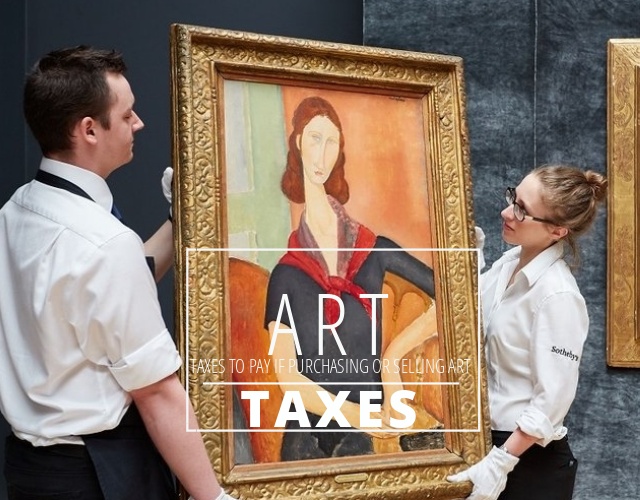- Taxes to Pay if Purchasing or Selling Art

- April 23, '20


by Virtosu Art Gallery
April 23, '20Taxes to Pay if Purchasing or Selling Art
Buying an art piece or selling one from a collection is a long process with several factors that will undoubtedly affect the final price. One of the elements is taxes. Various taxes will significantly raise the cost of the artwork you are looking to buy or maybe sell. We composed a list of taxes you as the buyer or seller need to consider before purchasing or selling an art piece.
Sales Tax
Sales tax is to be paid in the state or country in which the sale occurs. In the case the artwork is sold by the collector, dealer, gallery, or the auction house, the seller shall collect the sales tax from the buyer and transfer it to the government. In the United States, sales taxes vary significantly from state to state. Delaware, Montana, New Hampshire, and Oregon do not have sales taxes. States like Tennessee have an 8,.5%-9.46% tax on artworks. Sales tax has to be charged when the artworks are purchased within one state, given the intention of keeping the purchase in that state. In case the artwork is getting shipped to another state, instead of sales tax, use tax rates shall apply.
Use Tax
Use tax shall be paid when the artwork is purchased in one state and immediately shipped to a different state. For example, if you buy the artwork in New York and send it to Colorado, instead of paying the sales tax in New York, you’ll only pay the use tax in Colorado.
Use tax varies from state to state. Sometimes collectors use this regulation to save money on taxes by buying it in one state and shipping it to a lower use tax rate state. If you are planning this particular scenario, make sure that the seller is to arrange and execute the shipping. Otherwise, you will end up paying the sales tax.
Freeports
To temporarily avoid paying taxes, some collectors use freeports to store their art. In case you send the art purchased directly to a freeport, you will avoid paying both sales and use taxes. Keep in mind, though, when the artwork leaves the freeport and is delivered to the new location, the taxes will have to be paid at the usual rates. Sometimes you are buying art as an investment, and having no intention of hanging it at your home. You can resell it from the freeport to another collector without having to pay for sales and use taxes.
Capital Gain Tax
But what if you are looking to sell an artwork you purchased long ago, that doesn’t fit into your collection anymore. If the piece you selling has risen in value since you purchased it, you will have to pay capital gains tax when the sale closes. Let’s say you bought artwork for $100,000, but in several years you find a buyer willing to pay $1,000,000 for it.
When you sell that artwork, you will pay a capital gains tax on the difference — the $900,000 gain you earned by reselling the piece. The long-term capital gains tax rate is 0%, 15%, or 20% depending on your taxable income and filing status. It means that you will pay a total of $180,000 for taxes (20.0% of the $900,000 profit).
Income Tax
Income tax is similar to capital gains. The difference is that income tax is paid if the art is sold within a year of the date of the purchase. Income tax can reach up to 37% of the profit, which is why many collectors hold on to their art much longer over a year, going for the 20.0% capital gains tax instead.
Resale Tax
Collectors in the States don’t have to pay resale tax. However, if you live in Europe or the United Kingdom, you will pay these taxes as well. Under the so-called Resale Rights Directive, art sellers have to pay resale royalties to artists or artists’ heirs when the sale occurs. The royalty is 4% (for artworks under €50,000) and 0.25% (for artworks over €500,000). A maximum resale tax is set at €12,500.
Value Added Tax (VAT)
Value-added tax is another tax (outside the U.S.), you might have to pay if you’re purchasing artwork from countries other than U.S. VAT has to be paid when art is bought from artists, galleries or auctions that are VAT registered.
The Value Added Tax tax is usually integrated into the price of art by the seller, and it usually amounts from 15% to 20% of the artwork’s value. If you are purchasing or selling art through a middleman (gallery, auction house or dealer), you might have to pay Value Added Tax on their commissions. To avoid paying VAT, some collectors decide to purchase artwork from an entity outside of the E.U. and then pay for the import fees.
These are some of the taxes one should consider when thinking about purchasing or selling art. While keeping up with all the taxes can sometimes be tricky, it is advisable to hire a professional to consult you. They will tell you for sure how much the artwork will cost.

About author
Alina Livneva was born 1985 in Saint Petersburg, Russia. She studied at Saint Petersburg Academy of Arts. Educated in Russia and the United States. Lives in Miami. Has also lived in Russia. Contemporary Art. Collections expert, exhibitions and loans. E:This email address is being protected from spambots. You need JavaScript enabled to view it. .
FOR BUYERS
ABOUT US
VIRTOSU ART GALLERY
TOP CATEGORIES
FOR ARTISTS
For Buyers
-
Art Advisory Services
About Us
Virtosu Art Gallery

© 2020 Virtosu Art Gallery. All rights reserved.
This email address is being protected from spambots. You need JavaScript enabled to view it.


